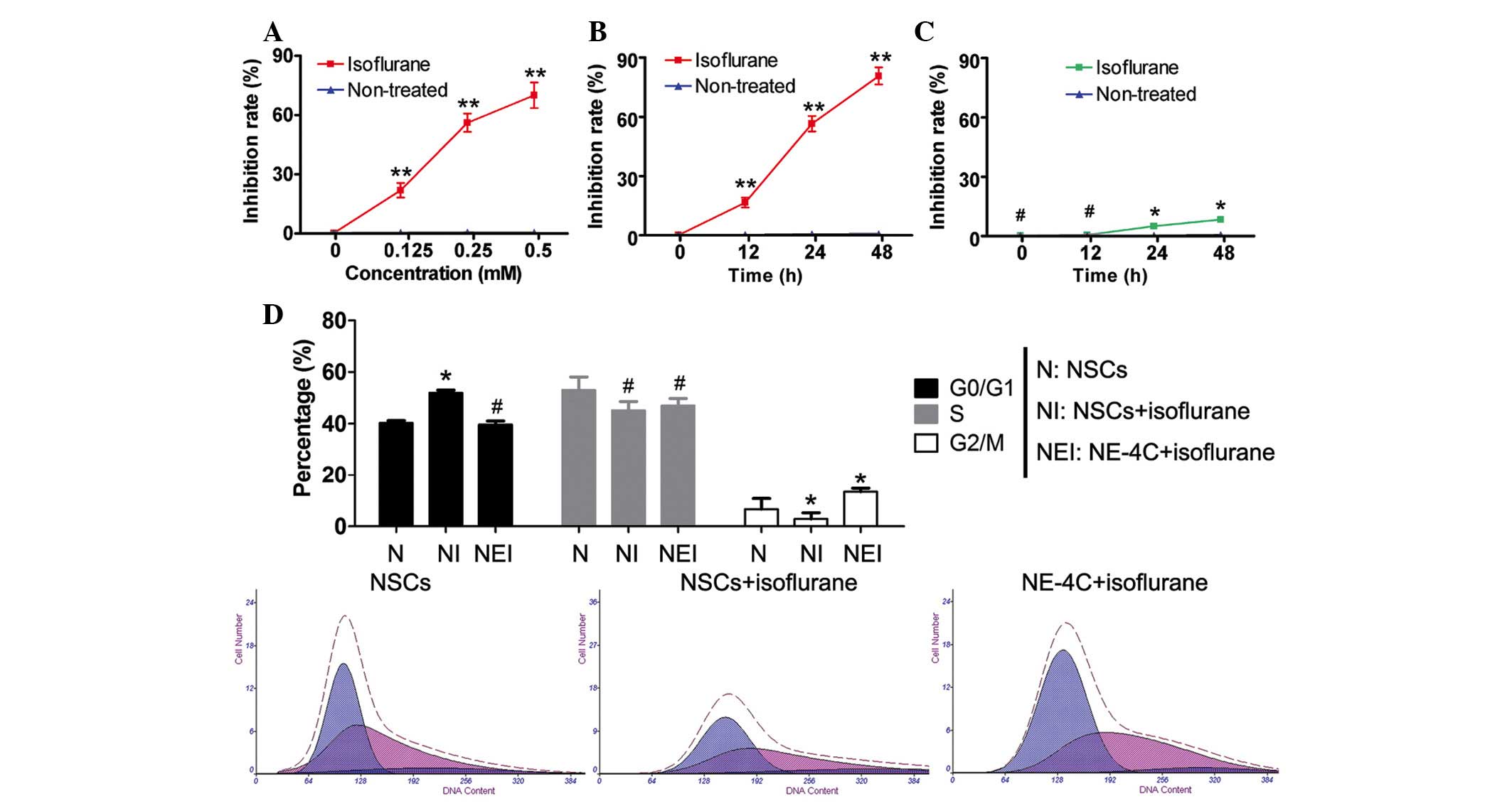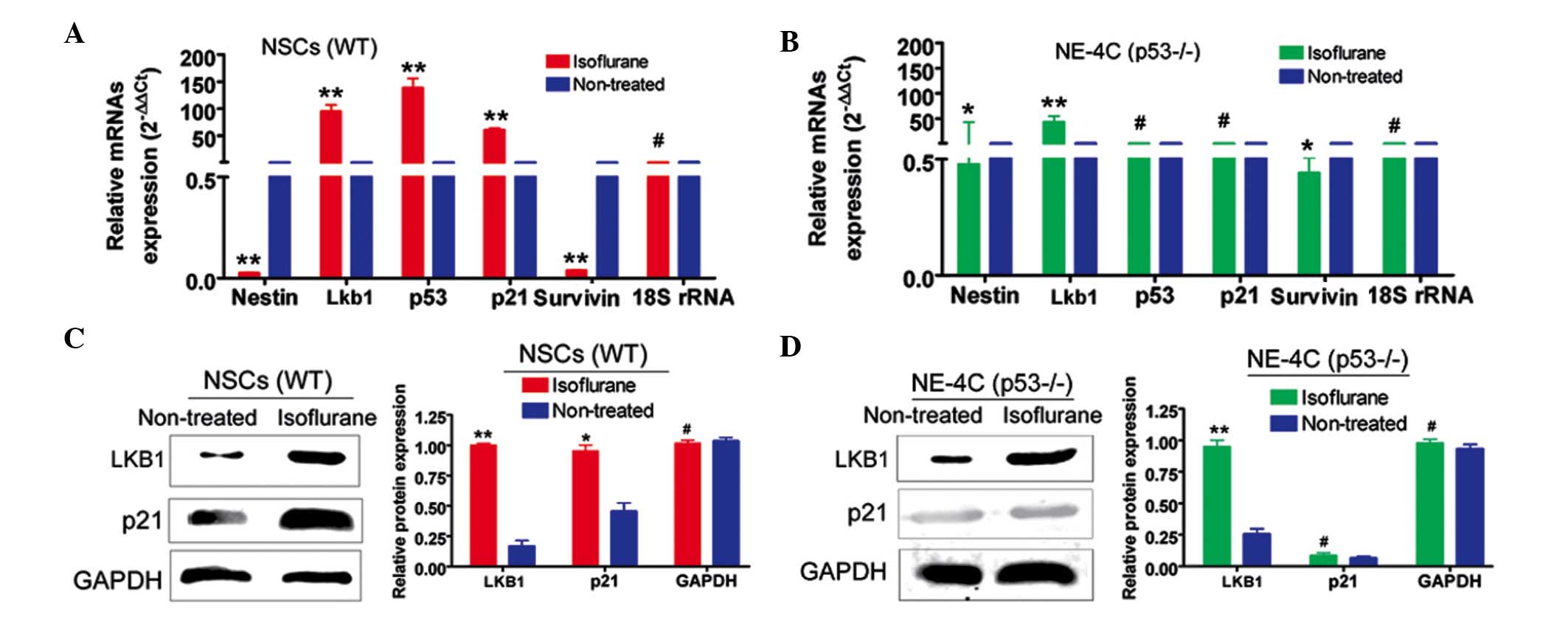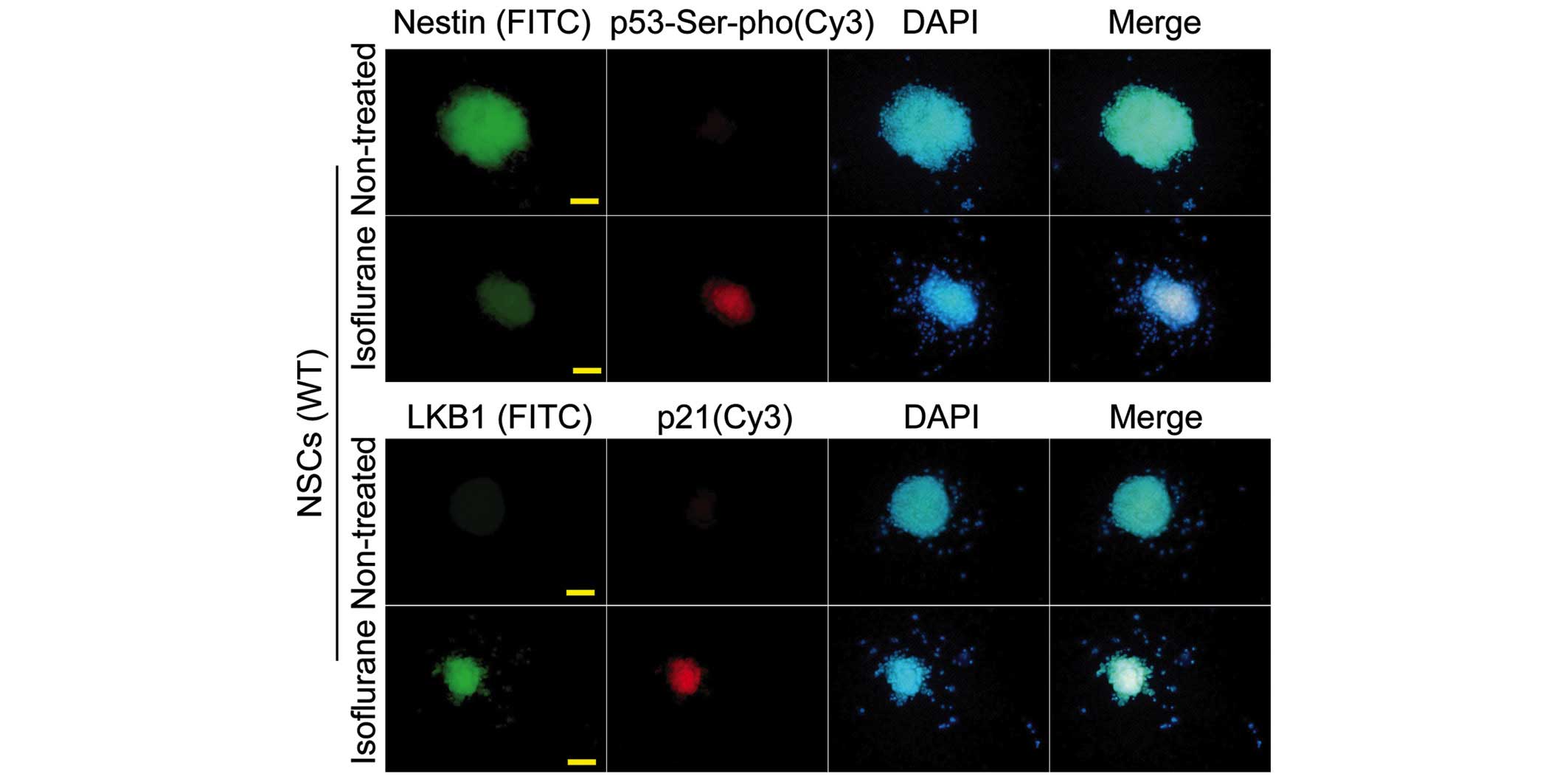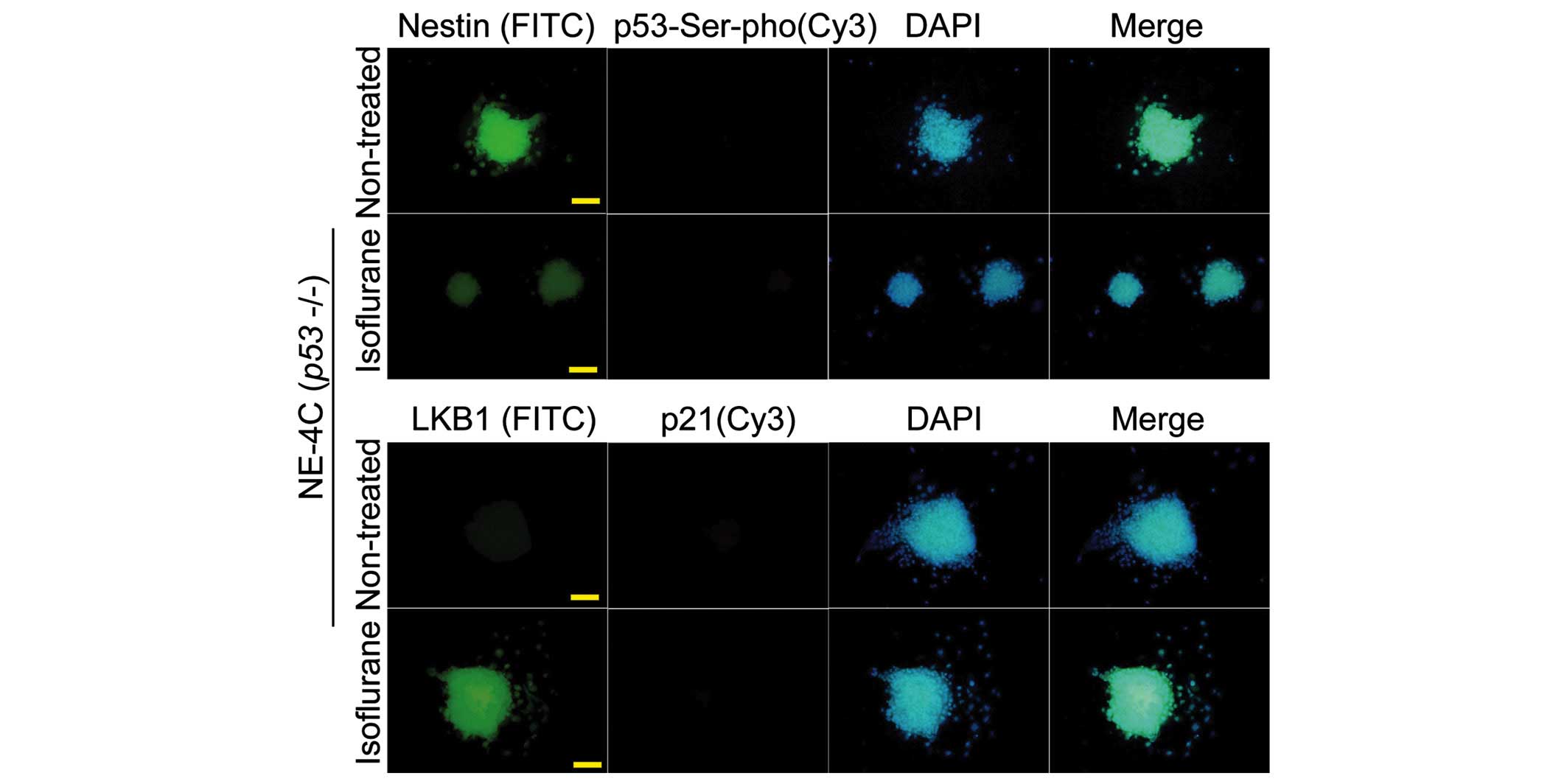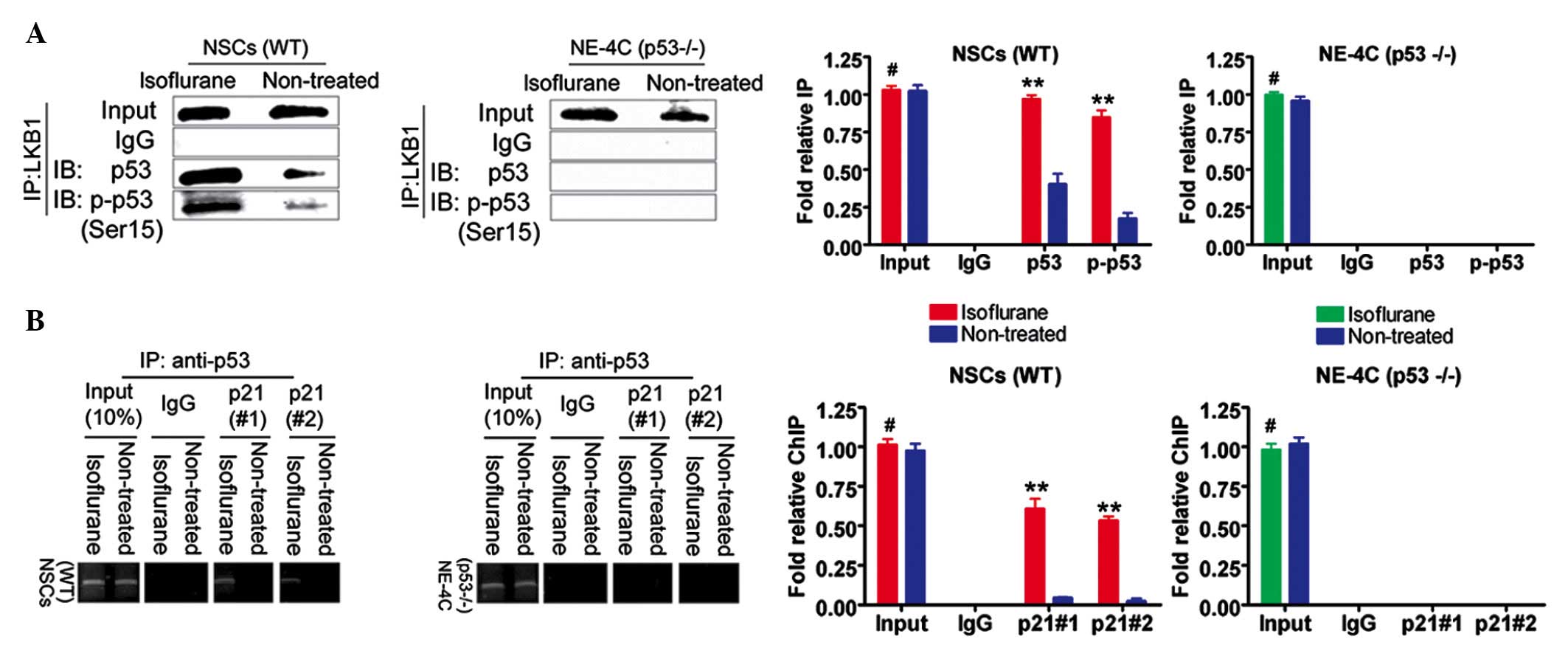
Isoflurane suppresses the self-renewal of normal mouse neural stem cells in a p53-dependent manner by activating
the Lkb1-p53-p21 signalling pathway
- Authors:
- Lengchen Hou
- Te Liu
- Jian Wang
-
View Affiliations
Affiliations: Department of Anesthesiology, Shanghai Tenth People's Hospital, Medical School, Tongji University, Shanghai 200072, P.R. China, School of Rehabilitation Science, Shanghai University of Traditional Chinese Medicine, Shanghai 200031, P.R. China
- Published online on: September 29, 2015 https://doi.org/10.3892/mmr.2015.4387
-
Pages:
7412-7418
-
Copyright: © Hou
et al. This
is an open access article distributed under the
terms of Creative
Commons Attribution License.
Metrics:
Total
Views: 0 (Spandidos Publications: | PMC Statistics:
)
Metrics:
Total PDF Downloads: 0 (Spandidos Publications: | PMC Statistics:
)
This article is mentioned in:
Abstract
Isoflurane is widely used in anaesthesia for surgical operations. However, whether it elicits unwanted side effects, particularly in neuronal cells, remains to be fully elucidated. The Lkb1-p53-p21 signalling pathway is able to modulate neuronal self‑renewal and proliferation. Furthermore, the suppression of Lkb1‑dependent p21 induction leads to apoptosis. In the present study, whether Lkb1‑p53‑p21 signalling is involved in the response to isoflurane was investigated. A comparison of mouse primary, wild‑type neural stem cells (WT NSCs) with the p53‑/‑ NSC cell line, NE‑4C, revealed that isoflurane inhibited proliferation in a dose‑, a time‑ and a p53‑dependent manner. However, flow cytometric analysis revealed that the concentration of isoflurane which caused 50% inhibition (the IC50 value) induced cell cycle arrest in WT NSCs. Furthermore, the protein expression levels of LKB1, p53 and p21 were increased, although those of nestin and survivin decreased, following treatment of WT NSCs with isoflurane. On the other hand, isoflurane induced the phosphorylation of Ser15 in p53 in WT NSCs, which was associated with p53 binding to the p21 promoter, and consequentially, the transcriptional activation of p21. All these events were abrogated in NE‑4C cells. Taken together, the present study has demonstrated that isoflurane suppresses the self-renewal of normal mouse NSCs by activating the Lkb1-p53-p21 signalling pathway.
View References
|
1
|
Sang H, Cao L, Qiu P, Xiong L, Wang R and
Yan G: Isoflurane produces delayed preconditioning against spinal
cord ischemic injury via release of free radicals in rabbits.
Anesthesiology. 105:953–960. 2006. View Article : Google Scholar : PubMed/NCBI
|
|
2
|
Zheng S and Zuo Z: Isoflurane
preconditioning reduces purkinje cell death in an in vitro model of
rat cerebellar ischemia. Neuroscience. 118:99–106. 2003. View Article : Google Scholar : PubMed/NCBI
|
|
3
|
Xiong L, Zheng Y, Wu M, Hou L, Zhu Z,
Zhang X and Lu Z: Preconditioning with isoflurane produces dose-
dependent neuroprotection via activation of adenosine triphosphate-
regulated potassium channels after focal cerebral ischemia in rats.
Anesth Analg. 6:233–237, table of contents. 2003.
|
|
4
|
Zheng S and Zuo Z: Isoflurane
preconditioning induces neuroprotection against ischemia via
activation of P38 mitogen- activated protein kinases. Mol
Pharmacol. 65:1172–1180. 2004. View Article : Google Scholar : PubMed/NCBI
|
|
5
|
Kapinya KJ, Löwl D, Fütterer C, Maurer M,
Waschke KF, Isaev NK and Dirnagl U: Tolerance against ischemic
neuronal injury can be induced by volatile anesthetics and is
inducible NO synthase dependent. Stroke. 33:1889–1898. 2002.
View Article : Google Scholar : PubMed/NCBI
|
|
6
|
Park HP, Jeon YT, Hwang JW, Kang H, Lim
SW, Kim CS and Oh YS: Isoflurane preconditioning protects motor
neurons from spinal cord ischemia: Its dose- response effects and
activation of mitochondrial adenosine triphosphate- dependent
potassium channel. Neurosci Lett. 387:90–94. 2005. View Article : Google Scholar : PubMed/NCBI
|
|
7
|
Ollila S and Mäkelä TP: The tumor
suppressor kinase LKB1: Lessons from mouse models. J Mol Cell Biol.
3:330–340. 2011. View Article : Google Scholar : PubMed/NCBI
|
|
8
|
Liu W, Monahan KB, Pfefferle AD, Shimamura
T, Sorrentino J, Chan KT, Roadcap DW, Ollila DW, Thomas NE and
Castrillon DH: LKB1/STK11 inactivation leads to expansion of a
prometastatic tumor subpopulation in melanoma. Cancer Cell.
21:751–764. 2012. View Article : Google Scholar : PubMed/NCBI
|
|
9
|
Liu T, Qin W, Hou L and Huang Y: MicroRNA-
17 promotes normal ovarian cancer cells to cancer stem cells
development via suppression of the LKB1- p53- p21/WAF1 pathway.
Tumour Biol. 36:1881–1893. 2015. View Article : Google Scholar
|
|
10
|
Krock B, Skuli N and Simon MC: The tumor
suppressor LKB1 emerges as a critical factor in hematopoietic stem
cell biology. Cell Metab. 13:8–10. 2011. View Article : Google Scholar : PubMed/NCBI
|
|
11
|
Veeranki S, Hwang SH, Sun T, Kim B and Kim
L: LKB1 regulates development and the stress response.
Dictyostelium Dev Biol. 360:351–357. 2011. View Article : Google Scholar
|
|
12
|
Zeng PY and Berger SL: LKB1 is recruited
to the p21/WAF1 promoter by p53 to mediate transcriptional
activation. Cancer Res. 66:10701–10708. 2006. View Article : Google Scholar : PubMed/NCBI
|
|
13
|
Liang X, Wang P, Gao Q, Xiang T and Tao X:
Endogenous LKB1 knockdown accelerates G(1)/S transition through p53
and p16 pathways. Cancer Biol Ther. 9:156–160. 2010. View Article : Google Scholar : PubMed/NCBI
|
|
14
|
Ren W, Guo Q, Yang Y and Chen F: bFGF and
heparin but not laminin are necessary factors in the mediums that
affect NSCs differentiation into cholinergic neurons. Neurol Res.
28:87–90. 2006. View Article : Google Scholar : PubMed/NCBI
|



